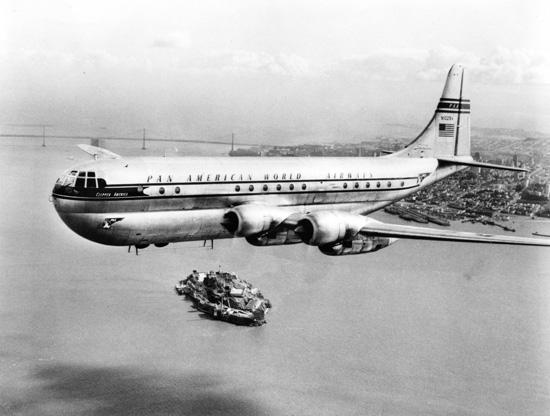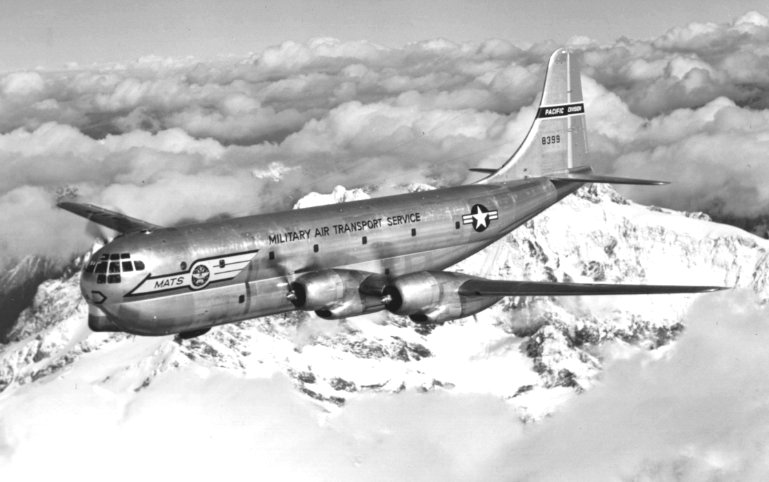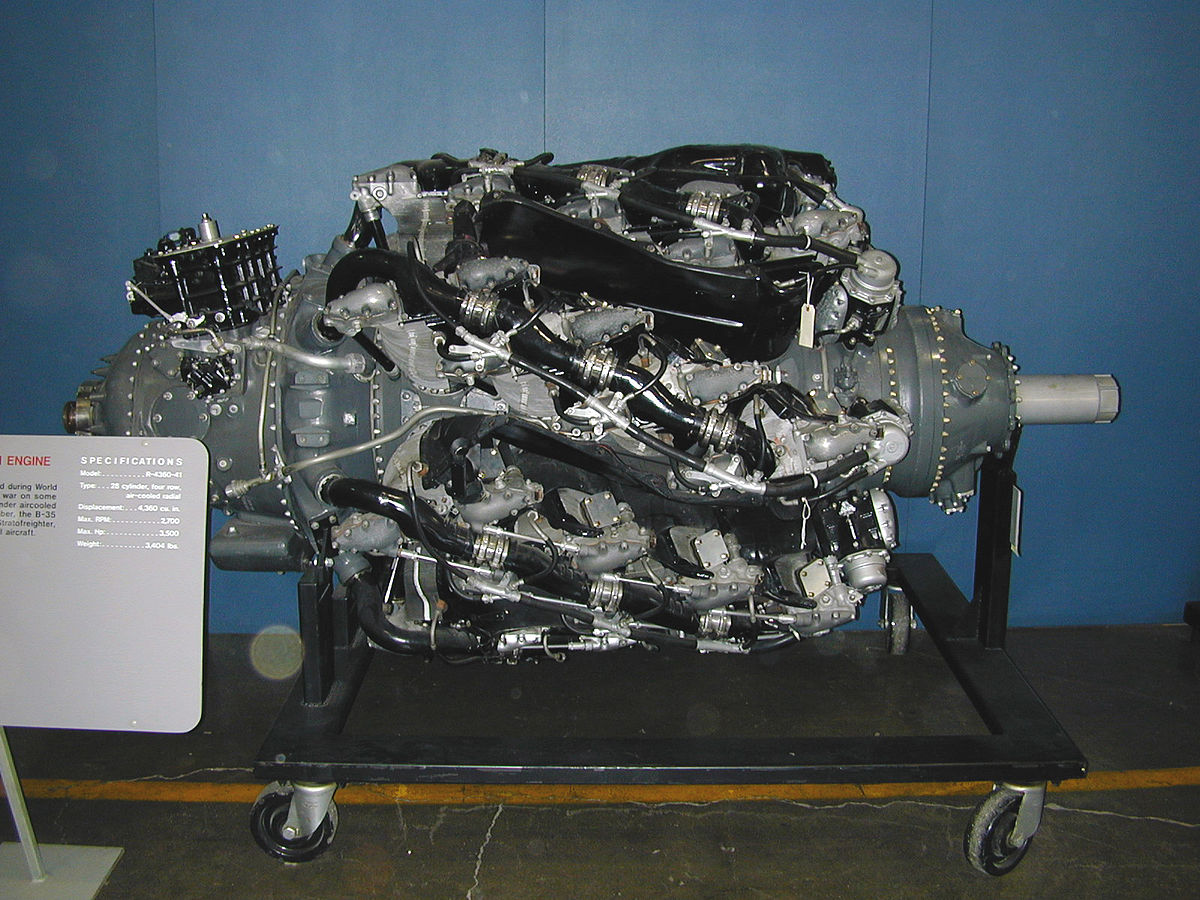GON
$100 Site Donor 2024
Came across a picture of this Lockheed Constitution. Seems PAX seats in the front belly? If so, something I never saw before.




Haha - been calling it a pig myself responding to the airbus slobber being posted as part of the anti Boeing propaganda - without one subsided airline - that subsided plane would not exist - they bought over 100 alone … Really? don’t like the plane - and don’t like the hub concept my travel agent tries to shove at me …Double fuselage. Not really “belly”. Everyone thinks the A-380 was the first “double decker”. Nah. The idea had been around for a long time before that pig took to the skies.
The Boeing 377 commercial airliner had two decks.

Boeing 377 Stratocruiser - Wikipedia
en.wikipedia.org
It was derived from the C-97, which was designed in 1942, and flew in 1947

Boeing C-97 Stratofreighter - Wikipedia
en.wikipedia.org
The Douglas C-124 was the first real heavy lifter, in its cargo configuration, it could carry small tanks and heavy equipment. It had two decks for passengers, and first flew in 1949.

Douglas C-124 Globemaster II - Wikipedia
en.wikipedia.org
Lockheed was simply demonstrating an airplane that was contemporary to many. Designed in 1942. Delivered just after the war, about the same as the above. Navy got a couple of these, but they had problems, and then turboprops came out.
I know I’ve said this before, so I will summarize.Haha - been calling it a pig myself responding to the airbus slobber being posted as part of the anti Boeing propaganda - without one subsided airline - that subsided plane would not exist - they bought over 100 alone … Really? don’t like the plane - and don’t like the hub concept my travel agent tries to shove at me …
Isn't that the same engine the B-36 had?R-4360s. Four row radials. Massive. Much bigger than the R-2800 but same basic diameter.
I've always wished I could've taken a trip on one of these old school prop driven passenger planes. So drastically different from today's sardine can get-you-there-as-cheaply-and-ASAP flights. Amazing to me that airlines could turn a profit on these planes too, which were very expensive to build, required high ticket prices for passengers, and didn't have the reliability and lower maintenance costs of modern passenger jets. Of course the US was a completely different place at that time economically.Came across a picture of this Lockheed Constitution. Seems PAX seats in the front belly? If so, something I never saw before.
View attachment 219881
Yes. It was the largest piston engine ever built. There were a bunch of airplanes that had it, including the B36.Isn't that the same engine the B-36 had?

Well, you got actual cutlery, and dinner was a roast that the flight attendants cooked in the galley. The seats were two on each side of the aisle, in economy. And you could smoke, of course. You were expected to dress appropriately- which meant suit, or at the very least, jacket and tie. In 1968 and 1969, my father flew 250,000 miles on United Airlines. I still have the plaque they sent him.I've always wished I could've taken a trip on one of these old school prop driven passenger planes. So drastically different from today's sardine can get-you-there-as-cheaply-and-ASAP flights. Amazing to me that airlines could turn a profit on these planes too, which were very expensive to build, required high ticket prices for passengers, and didn't have the reliability and lower maintenance costs of modern passenger jets. Of course the US was a completely different place at that time economically.
Holy smokes, 7000-8000 mile range…at 300 mph.Yes. It was the largest piston engine ever built. There were a bunch of airplanes that had it, including the B36.
The two Boeings that I linked above, had that engine.
Here is the Convair, double-decker passenger liner, derived from the B36, and equipped with those engines.

Convair XC-99 - Wikipedia
en.wikipedia.org
Indeed - I look for 789’s or 350’s … nice rides both !I know I’ve said this before, so I will summarize.
Just over 20 years ago, Boeing looked at the future and saw a market for an airplane that had the speed, range, and efficiency to go from major hub to midsize city. They called it 7E7. We call it 787, one of the most successful airliners, ever.
At the same time, airbus said the future of air travel is moving more and more people between hubs that are limited on space, so the best thing to do is build a giant airplane to move passengers between hubs. A-380.
Very clear that Boeing got that future right.
Both aircraft are examples of the product that results when you listen to your customer.Indeed - I look for 789’s or 350’s … nice rides both !
One other thing I should add. Dad always came home tired - back then, getting on a jet was rare.Well, you got actual cutlery, and dinner was a roast that the flight attendants cooked in the galley. The seats were two on each side of the aisle, in economy. And you could smoke, of course. You were expected to dress appropriately- which meant suit, or at the very least, jacket and tie. In 1968 and 1969, my father flew 250,000 miles on United Airlines. I still have the plaque they sent him.
It was all prop airplanes. I remember seeing him fly on Air Canada on DC-6s, when we lived in Winnipeg.
And you would be down at lower altitude, with more turbulence, in the weather, and take twice as long to get there.
And the economy ticket cost about half as much as a new car. Would you pay $10,000 to sit next to someone smoking, while being served the roast, and while wearing a suit, just to take twice as long to get there, and have a more bumpy ride on the way? That’s what my Dad experienced. At over $1,000 a ticket, in economy. In 1968. Our new Ford cost $2,500 that year.
There is a reason that travel isn’t like that any more - it’s economics. Most people are not willing to pay for that service.
And the airplane that started it?
This one - In 1968, it began flying and it dramatically lowered the cost per mile. It was fast. And it could fly nearly halfway around the world. It changed the very nature of air travel.
View attachment 219899
When you are going to finally tell us how you feel about the A-380?that pig took to the skies
I am always amazed at some of the knowledge on this site, especially about airplanes.I've always wished I could've taken a trip on one of these old school prop driven passenger planes. So drastically different from today's sardine can get-you-there-as-cheaply-and-ASAP flights. Amazing to me that airlines could turn a profit on these planes too, which were very expensive to build, required high ticket prices for passengers, and didn't have the reliability and lower maintenance costs of modern passenger jets. Of course the US was a completely different place at that time economically.

I think if I remember correctly, it was around 1970 when United started advertising they had an "all jet" fleet of aircraft.One other thing I should add. Dad always came home tired - back then, getting on a jet was rare.
He flew from Winnipeg Canada across the United States to various insurance agencies.
Most of that domestic flying was done on prop airplanes. And going from Denver, to New York, for example, at 300 mph, down low, in the weather would take seven hours and you’d be beat up at the end of it, then he would fly back through Chicago, and it was propeller aircraft most of the time.
Aircraft today are faster, and smoother, and far cheaper to operate, than they were back in the “glory days” of aviation, the result of turbine power plants, better wings, and a host of other, small, design improvements.

Will it ever make the shareholders a dime?We call it 787, one of the most successful airliners, ever.
